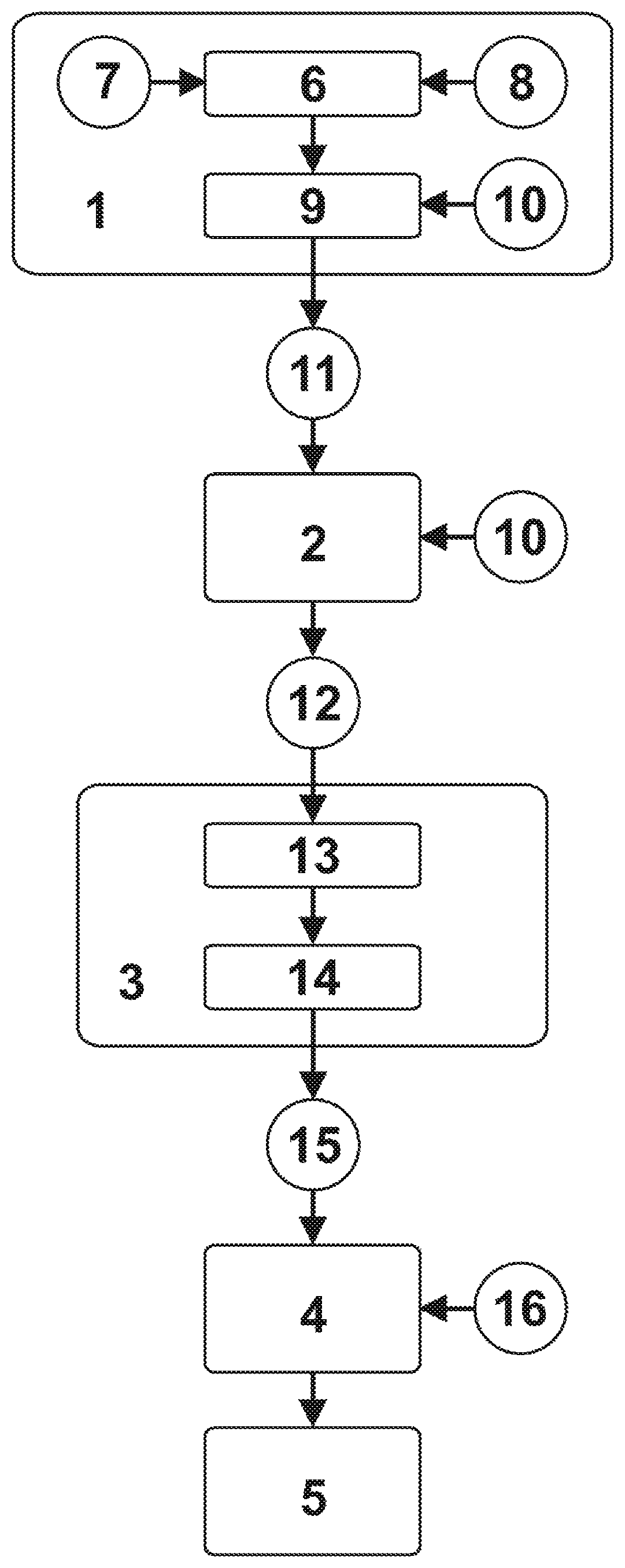Method for obtaining biodegradable polymers
a biodegradable polymer and polymer technology, applied in the field of biodegradable polymer obtaining methods, can solve the problems of compound limitations in food contact applications, compound extenders present a multitude of problems and drawbacks, and extenders have a multitude of drawbacks, so as to improve the effect of colour, improve the commercial value of the market, and remove the risk of toxicity and pollution
- Summary
- Abstract
- Description
- Claims
- Application Information
AI Technical Summary
Benefits of technology
Problems solved by technology
Method used
Image
Examples
example 1
[0036]To the paste-mixer were added 62.5 kg PTA, 66.8 kg ADA, 96 kg BDO, 6 kg polyethertriamine and 1 kg sodium sulfoisophthalic acid (SSIPA). They were mixed for 1 hour and 93 kg / h of the mixture was continuously passed to the esterification reactor, which contained 100 kg of the previously prepared mother paste at 240° C. and 400 mbar. In the esterification reactor, a flow of catalyst was added at 72 g / hour of tetrabutyl titanate (TNBT) at the top and a flow of 115 g / h of triethyl phosphate (TEP) through the side.
[0037]The raw materials were input continuously and the product (monomer or oligomer) flowed out at 72 kg / h and water and other volatiles through the column head.
[0038]The product obtained is continuously input, at the same time as 24 g / h TNBT to a prepolycondensation reactor operating at 240° C. and 60 mbar, and a prepolymer is continuously obtained, which was input into the polycondensation reactor operating at 240° C. and 1-2 mbar It is maintained for a residence time ...
example 2
[0042]To the paste-mixer are added 65 kg PTA, 63 Kg ADA, 96 kg BDO, 3 kg polyethertriamine and 1.5 kg SSIPA. They are mixed for 1 hour and 93 kg / h of the mixture is continuously passed to the esterification reactor, which contained 100 kg of the previously prepared mother paste at 240° C. and 400 mbar. In the esterification reactor, a flow of 72 g / h of TNBT was added.
[0043]The raw materials are input continuously and the product (monomer or oligomer) flowed out at 70 kg / h and water and other volatiles through the column head.
[0044]The product obtained is continuously input, at the same time as 24 g / h TNBT to a prepolycondensation reactor operating at 240° C. and 60 mbar, and a prepolymer is continuously obtained, which is input into the polycondensation reactor operating at 240° C. and 1-2 mbar. It is maintained for a residence time of 2 hours and a polymer was obtained with the following properties:[0045]Intrinsic viscosity of 1.15 dl / g.[0046]Melt Volume Rate (MVR) (190° C. / 2.16 kg...
example 3
[0048]To the paste-mixer are added 68 kg PTA, 61.8 kg ADA, 96 kg BDO, 7.5 kg polyethertriamine and 1.5 kg SSIPA. They are mixed for 1 hour and 93 kg / h of the mixture is continuously passed to the esterification reactor, which contained 100 kg of the previously prepared mother paste at 240° C. and 400 mbar. In the esterification reactor, a flow of 82 g / h of TNBT is added.
[0049]The raw materials are continuously input and the product (monomer or oligomer) flowed out at 72 kg / h and water and other volatiles through the column head.
[0050]The product obtained is continuously input, at the same time as 33 g / h TNBT to a prepolycondensation reactor operating at 240° C. and 60 mbar, and a prepolymer is continuously obtained, which is input into the polycondensation reactor operating at 240° C. and 1-2 mbar. It is maintained for a residence time of 4.5 hours and a polymer is obtained with the following properties:[0051]Intrinsic viscosity 1.47 dl / g.[0052]Melt Volume Rate (MVR) (190° C. / 2.16 k...
PUM
| Property | Measurement | Unit |
|---|---|---|
| temperature | aaaaa | aaaaa |
| temperature | aaaaa | aaaaa |
| humidity | aaaaa | aaaaa |
Abstract
Description
Claims
Application Information
 Login to View More
Login to View More - R&D
- Intellectual Property
- Life Sciences
- Materials
- Tech Scout
- Unparalleled Data Quality
- Higher Quality Content
- 60% Fewer Hallucinations
Browse by: Latest US Patents, China's latest patents, Technical Efficacy Thesaurus, Application Domain, Technology Topic, Popular Technical Reports.
© 2025 PatSnap. All rights reserved.Legal|Privacy policy|Modern Slavery Act Transparency Statement|Sitemap|About US| Contact US: help@patsnap.com

